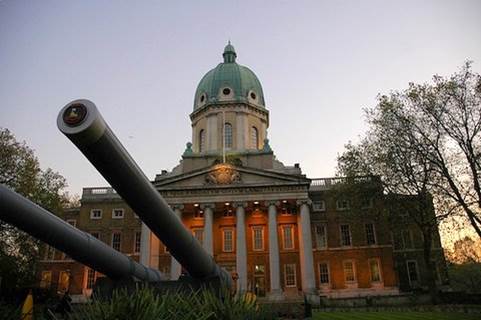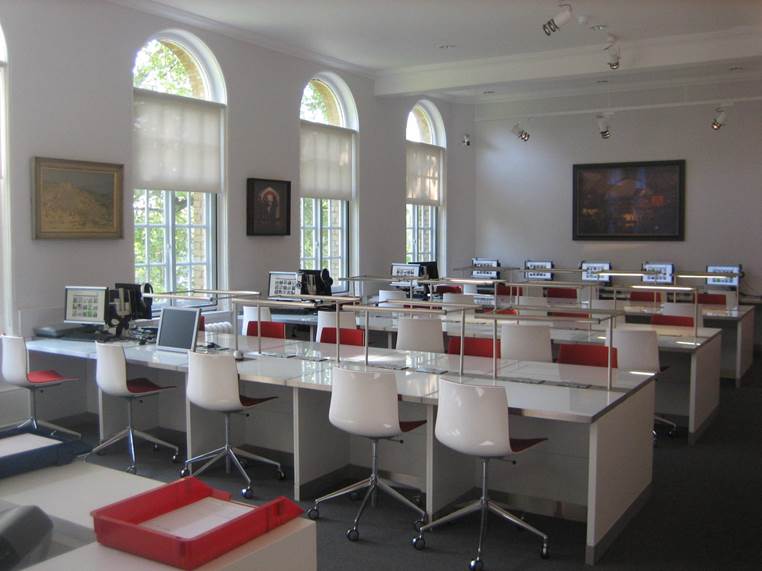ARLIS/UK & Ireland visit to the Imperial War Museum Library, Friday 15 April 2016.

Located in Kennington, South London, the imposing building that houses the Imperial War Museum was originally opened as the Bethlem Royal Hospital in 1814. By 1930 the hospital had closed its doors, and was acquired by the museum in 1936 as its new, permanent home.
Head of the Library, Fergus Read, welcomed us and gave us a brief history of the library and its collections. The Imperial War Museum was established in 1917, and from its beginnings was intended as a monument to both the civil and military contributions of all imperial nations. It is as much a collection dedicated to social history as it is about military campaigns. The remit of the IWM has expanded over time to include all conflicts involving British and Commonwealth forces since 1914.

The library’s collection has been at the heart of the museum since its inception. One of the very first items acquired by the fledgling museum and placed in the care of the library perfectly illustrates the breadth of the collection – a pantomime programme for the troops stationed in Salonica.
The library’s collections cover a wealth of materials and formats. It includes official war histories of all nations, not just UK and commonwealth nations; regimental histories, including a First World War set from Germany; and biographies, which are indexed and cross-referenced according to their content using the library’s unique classification system. The collection also features historical accounts; periodicals, journals and diaries; signed personal items; working copies of monographs and presentation volumes, and, very movingly, a huge collection of Rolls of Honour, which were evocatively described as being ‘portable war memorials’ for numerous institutions and associations, ranging from schools to sports clubs to railway companies.
The library holds over 215,000 items, housed in over 4.3km of shelving. The collection holds 72,000 maps, including WWI trench maps, German High Command WWII planning maps, and a complete set of Luftwaffe aerial target maps. Management of this sub-collection is currently being transferred to the Collections Department
From the beginnings of the museum, the collecting policy included representations of women’s involvement in warfare, both on the home front and in the services. Additionally, the museum encouraged contributions from the public, inviting them to send in background information and photos of loved ones killed during WWI. In 2014, the Bond of Sacrifice collection was expanded to include all people involved in the war and their experiences.
There are 44,500 pamphlets, covering the instructional and the esoteric, military and civilian, and 14,500 items classed as ephemera, including objects such as song sheets and Christmas cards, among other things.
The library also has an impressive collection of posters, including 18,700 ‘proclamations’ (essentially, wordy posters with a ‘specific instructional message’). This includes a full set of the now famous ‘Invasion’ series, of which ‘Keep Calm and Carry On’ is the best known. However, this series of posters, intended for use during 1940 when the UK was in real danger of invasion, were never actually used. So if you ever see a period film or TV programme using these posters, you know they haven’t done their research properly!
The Library’s Explore History space was opened in 2010, and receives around 20,000 visitors a year. The idea behind the space was to encourage visitors to the museum to learn more about the collections they had seen, and to discover more about items not on display. Visitors can browse a collection of books and journals on open access; search the IWM’s extensive catalogue (which is also available online http://www.iwm.org.uk/collections ); use one of the two interactive, touch-screen terminals that highlight curated content from the collections; or watch a selection of 10-minute taster clips from the film archive, one of the oldest in the world.
The Explore History space is also an area where visitors can talk to a member of library staff about the collections and enquiries. Often enquiries are related to family history research and can be emotive and involved.
Researchers with more focused needs may book an appointment to visit the library’s Research Room, which is open Monday to Thursday. Appointments must be booked at least three days in advance to ensure a space is available. There are 24 study desks, as well as several microform readers, research terminals, and terminals providing access to the museum’s sound archive.
Art Curator Alexandra Walton introduced the War Artists’ Archive, access to which is managed by both curators and library staff. The IWM took over responsibility for commissioning official war artists after the Second World War, and the War Artists’ Archive consists of files detailing the day-to-day running of the war art schemes, including private papers, official records and correspondence, visitor books for exhibitions, and ephemera related to artist commissions. A small selection of these fascinating documents were on display.
Access to the Library is arranged by prior appointment; in most cases this requires at least three days notice (and two weeks for items held off site). Researchers must use the IWM’s online collections search to do their own research prior to booking appointments, which is also done online.
Librarian Sarah Paterson highlighted the breadth and depth of the library’s bound collections, including books, journals and other publications, and passed around an incredible selection of items covering numerous conflicts. One particular favourite was a volume of The Quill, a handwritten, hand-illustrated in-house magazine created by allied officers in a WWII prisoner of war camp. The IWM library holds several volumes of this unique periodical, some of which were cloth-bound and hand-embroidered by the officers. Collections such as the aforementioned Rolls of Honour are frequently used for genealogical research, especially as many WWI records were destroyed during WWII air raids.
Sarah and Fergus then gave us a tour around the library, taking in the Explore History space, the Research Room and one of the stack areas. This stack is due for redevelopment soon, so much of the material in it will be moved to the library’s store at IWM Duxford, where lesser-used collections are already held.
In recent years the library has faced many difficult challenges, and yet it remains a truly world-class and invaluable resource for all. Sincere thanks are due to Fergus, Sarah and Alexandra for being so welcoming and providing a fascinating glimpse behind the scenes.
Sarah Currant, Reader Services Librarian, BFI Reuben Library.
